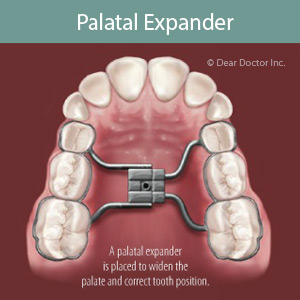Approximately 4 million tweens and teens are currently undergoing orthodontic treatment for a poor bite (malocclusion) that can cost their families thousands of dollars in braces or clear aligners. But treatment doesn’t always have to follow this track: Found early, many malocclusions can be corrected or minimized before they fully develop.Known as interceptive orthodontics, this particular approach to bite correction often begins as early as 6-10 years of age. Rather than move existing teeth, interceptive orthodontics focuses instead on redirecting jaw growth and intervening in other situations that can cause malocclusions.For example, a child’s upper jaw may not be growing wide enough to accommodate all incoming permanent teeth, crowding later arrivals out of their proper positions. But taking advantage of a gap during early childhood that runs through the center of the palate (roof of the mouth), orthodontists can increase jaw width with a device called a palatal expander.The expander fits up against the palate with “legs” that extend and make contact with the inside of the teeth. With gradually applied pressure, the expander widens the central gap and the body naturally fills it with new bone cells. The bone accumulation causes the jaws to widen and create more room for incoming teeth.Another way a malocclusion can develop involves the primary or “baby” teeth. As one of their purposes, primary teeth serve as placeholders for the future permanent teeth forming in the gums. But if they’re lost prematurely, adjacent teeth can drift into the vacant space and crowd out incoming teeth.Dentists prevent this with a space maintainer, a thin metal loop attached to the adjoining teeth that puts pressure on them to prevent them from entering the space. This spacer is removed when the permanent tooth is ready to erupt.These and other interceptive methods are often effective in minimizing the formation of malocclusions. But it’s often best to use them early: Palatal expansion, for example, is best undertaken before the central gap fuses in early puberty, and space maintainers before the permanent tooth erupts.That’s why we recommend that children undergo an orthodontic evaluation around age 6 to assess their early bite development. If a malocclusion looks likely, early intervention could prevent it and reduce future treatment costs.If you would like more information on interceptive orthodontics, please contact us or schedule an appointment for a consultation. You can also learn more about this topic by reading the Dear Doctor magazine article “Interceptive Orthodontics.”
Recent Posts
- The Importance of Emergency Dental Care: Timely Intervention is Key
- Delaying Wisdom Teeth Extraction Can Lead to Serious Issues
- Can an Abscessed Tooth Kill You? Symptoms and When to Seek Urgent Care
- How to Recognize and Effectively Treat a Dental Emergency
- Gum Disease and Heart Disease: Understanding the Connection

